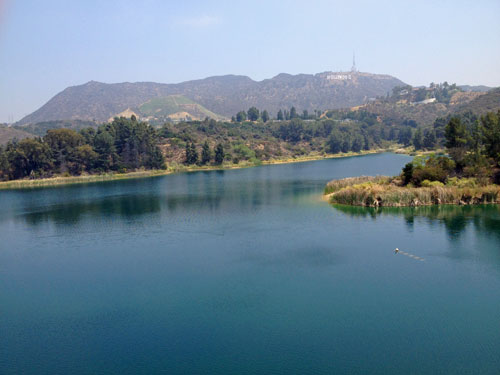Taking a walk or a hike with kids always provides the opportunity for good conversation – with endorphins activated, the magical results of not actually looking into one anther’s face makes for easy chatting. Walking around Hollywood Reservoir offers a particularly great chance to share the story of one of LA’s most impressive (and massive) engineering feats… not to mention allows gorgeous views of the Hollywood Hills.

Back in the day (i.e. that fuzzy, fabled time before kids) meeting a friend for a walk around the Hollywood Reservoir passed for decent exercise and an excellent way to catch up with a friend. When I heard news that the path around Lake Hollywood area had been reopened last spring (mudslides had required repairs that closed the park to the public since 2005), the opportunity to cruise around the old stomping grounds was irresistible.
My daughter and I took an early morning hike around the mostly flat, 3.3 mile perimeter of Lake Hollywood at the start of the summer. Our hiking habits normally lead us to the Santa Monica Mountains, so any chance to gaze at the Hollywood Hills from a new angle is welcome and circling the Reservoir doesn’t disappoint: the walk features the remarkable Mullholland Dam (built in 1924 to reserve water for the city), as well as an unobstructed view of the Hollywood Sign. In an instant, the era of old-Hollywood was evoked — from the impressive engineering of the dam itself to a view of the iconic sign in the setting that it was originally intended (announcing a suburban housing development).
After years of wandering around the lake’s perimeter, if was a revelation to actually do some homework and learn about the dam itself, and how the water has been contained. Click here for remarkable photographs of the construction of the immense wall that was built into the canyon – what’s neatly covered in trees and hillside now is revealed in it’s nascent, naked stage. It’s stunning.
Of course, we started to talk about John Huston’s inimitable film, Chinatown and LA’s reliance on imported water. The dam is named after William Mullholland — upon whom the main character in the movie is based — and holds 2.5 billion gallons of water collected from the San Fernando Valley and from the Owens Valley, carried south by the California Aqueduct. We’d watched the movie recently, and had some fun play-acting Faye Dunaway’s famous “My sister/my daughter” scene. In the early summer haze, with the dusty smell of dry pine leaves, the immensity of Mullhollland’s dream of watering Los Angeles seemed both impressive and grotesque, just as Huston intended.
It is almost eerie to gaze down on the heavily gated “lake.” It’s not your father’s lakeside experience — you won’t see boats, or get close enough to even dangle a foot. Because it’s not really a lake, thus some of the confusion over what to call the site. Properly, it’s a Reservoir: the water trapped there is there for emergency use only – in the event of an earthquake or other catastrophic event.
Looking back on our June hike, after a long summer of record heat in the Southland, the issues raised in Huston’s film are all still relevant and provide plenty of intriguing talking points — there’s the engineering of the dam itself, the history of water rights in LA (including John Huston’s iconic film with it’s sinister portrait of Mullholland and his era), and there is climate change and all the attendant scientific and conservation issues.
Let us know what you wind up talking about!
We entered the park by Lake Hollywood Drive, off Barham, in the Valley. Click here for a great Modern Hikes article that shows the trail’s path around the lake and the access points.

